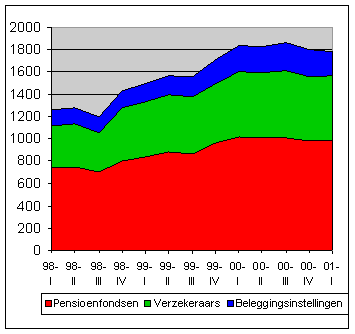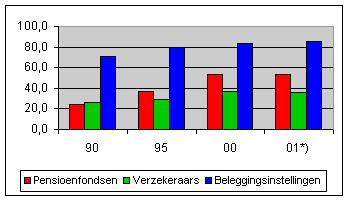Large losses for institutional investors

Since the published figures on institutional investors were incorrect, this article is incorrect.
The continuous increase in the value of investments by institutional investors has come to an end following the stock market slump in the last quarter of 2000 and the first quarter of 2001. Total investments fell to 0.8 trillion euro at the end of the first quarter of 2001, 36.3 billion euro down on the third quarter of 2000. The revaluation losses on shares in the two quarters amounted to more than 70.3 billion euro, nearly 9% of total investment.
Because of the disappointing developments in share prices, institutional investors have turned towards foreign bonds. At the end of the first quarter of 2001 they had put more than 159 billion euro in foreign bonds.
Investment by institutional investors per quarter in bln euro

Differences between institutional investors
There are three types of institutional investors, namely insurance companies, pension funds and investment trusts. Each has its own specific portfolio composition, based on the risks it can take with its money.
Investment trusts have the most freedom in their investment policy as they are not under contract to pay out money. They can therefore take more risk to achieve a high return on their investments. Pension funds and insurance companies, on the other hand have contractual obligations to provide regular payments to contributors and may therefore take less risk with their money.
Investment trusts and pension funds invest 85% and 50% respectively of their money in shares and realty. These investors have been in rough waters recently. The invested capital of investment trusts was reduced by 10%. Pension fund investments retained their value fairly well as they did not get out of the market, but bought 18 billion euro worth of shares more than they sold, partly compensating for the 35 billion euro they lost on shares.
Insurance companies usually invest in fixed-interest securities, such as bonds, mortgages and private loans. However, the favourable developments on the stock exchanges prompted them to look at shares in recent years. The caution in investment policy by insurance companies was not obvious in the fourth quarter of 2000 the first quarter of 2001, with share losses amounting to more than 18 billion euro for the two quarters together. This is a relatively more disappointing result than for the pension funds.
Professional investors aim for a long-term return on their investments. It is not unusual to have a downturn after a long period of increasing share prices. This will not significantly affect the total long- term yields.
Percentage of shares and realty in investment

The data on investment trusts are taken from a survey by the Dutch central bank
Rob Tolk